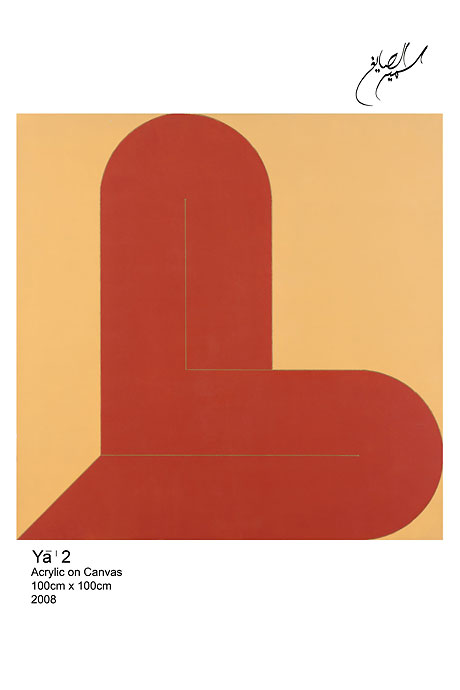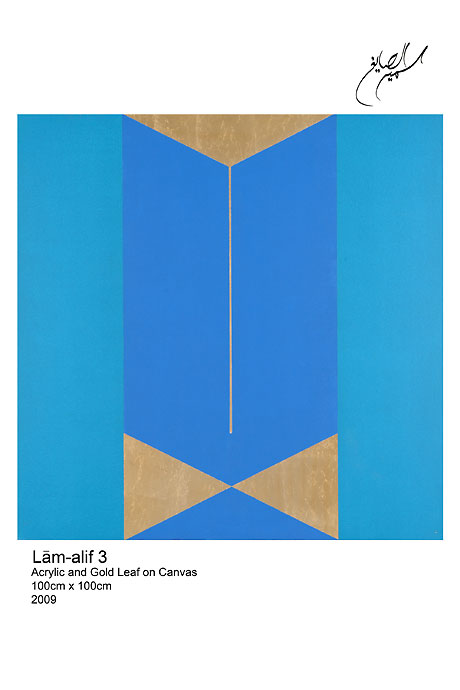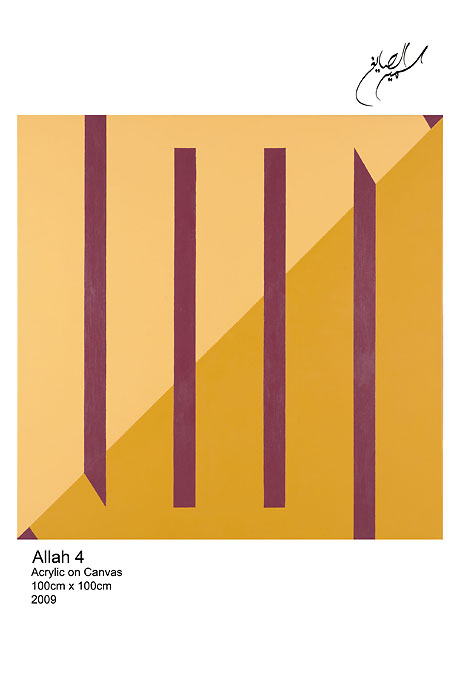


Encountering Samir Sayegh
October 2009
Saleh Barakat in conversation with artist Samir Sayegh on art, calligraphy and “what cannot be written and what cannot be said”.
Saleh Barakat: How did you embark on your career as an artist?
Samir Sayegh: In fact, it commenced as a comeback to calligraphy from the perspective of Arab modernism, as I was searching for a deeper conviction about the issue of authenticity and modernity, and looking for a personal artistic identity, the ultimate objective of modernism. The first encounter was during childhood, when my calligraphy teacher stood by my desk and said: “you have a beautiful handwriting”. And that was it, the beginning of a long relationship. Between the two, I practiced poetry, Sufi meditation and art criticism.
SB: What were the main challenges that you faced in the beginning?
SS: There was a time when I felt that the Hurufiyyah movement (the artistic movement deploying Arabic letters as a source of inspiration, starting from the fifties onwards) was rather disoriented. The use of Arabic letters and Islamic ornamentation in composing the modern painting de facto transforms the letters and the ornaments into a secondary artistic element, even if it endows the artwork some Arab or Islamic traits. In brief, the Hurufiyyah was addressing political ideas and directions far more than the artistic questions related to the artwork itself, its vision and its creative values. On the other hand, going back to calligraphy as we inherited it from the Ottoman Empire, it is a dead end too because it confines this discipline into a set of rules and styles, and converts the calligrapher into a master craftsman at best.
It is true that Arab modernism was a main catalyst in the rediscovery of the past, especially the art of calligraphy. Nonetheless, it is not the right path to give calligraphy a new cycle of life. Though it may seem that contemporary art meets with the art of the past on many grounds and does not conflict with it, a closer reading of the past leads us to the conclusion that there are two visions in the understanding of the meaning of art and the role of the artist. The first sees art as revolving around the absolute, where the artist stands as a witness to the unity of being versus the unity of the metaphysical. The second makes the artist the center of the world and his art the register of his successes and failures in his continuous fight with himself and the world.
SB: So how did you proceed?
SS: The critical mind cannot compromise between those two visions. How can a contemporary calligrapher be a witness and a fighter at the same time? How can they be present and absent simultaneously? How can they be the mirror and the face all at once? So my first reflection concentrated on researching the birth of Arabic calligraphy as a full fledged art more than a thousand years ago and at a later stage trying to understand the regression of this art and its decline.
I firmly believe there is always room for advancement and progression. So if reason cannot find a solution, maybe the hand can - perhaps the hand or the eye, the eye or the spirit, the spirit or the passion, the passion or the ink, the ink or the pen, the pen or the paper, the paper or its whiteness. This is how I started: I listened to my hand, to the call of the ink, and I surrendered to the reed.
My first experience revolved around what cannot be written and what cannot be said. I wanted to liberate the calligraphy from the language and the meanings of words, and go back to the first moment of its birth, to the universe of signs and symbols, when the letters were hanging between mud and water. It was imperative to separate between calligraphy’s role as a medium of communication and its other mission of aesthetic beauty. To distinguish between the two roles is a necessity in order to understand the polarity of calligraphy and therefore to try to deal with it, because if you look at calligraphy in order to read, you don’t see the calligraphy really. And when you let yourself immerse in the meanders of calligraphic beauty, reading becomes secondary.
SB: So how would this be translated?
SS: Calligraphy is founded on concepts and objectives different from those of writing. Writing is one thing and calligraphy is another, even if they share the same letters and belong both to the same language. Writing is meant to be read; calligraphy is destined to be contemplated in a state of exaltation. Writing is mainly a means of comprehension and clarification, and transmission and delivery. Calligraphy starts when it transcends itself as a means to become a goal by itself, achieving self-sufficient presence capable of initiating its own dialogue.
SB: Tell me about the forms.
SS: The universe of forms is the new language that calligraphy should aim to reach in order to achieve human conveyance. All what is needed then to appreciate its beauty is to learn how to read this language and how to decipher it.
SB: How should we read those letters?
SS: They should be read through the lines in their nudity and their simplicity, in the straight and cursive lines, in the vertical and the horizontal, in the long and the short, in the thick and the thin, in the sharp and the relaxed, in the attached and the detached, in the closed and the open, in the ascending and the descending, and in the reclined and the flat. The early Kufic script of the Korans in the first 300 years of Islam is a fabulous example of the evolution, maturity and depth of this new language - i.e. the language of forms and their capacity to express and communicate. A contemplation of the letter alif for instance unveils the stunning multiplicity of the possibilities derived from the straight line, especially when this straightness goes astray! With some imagination, this alif starts to move and dance, paving the way to various interpretations, as many as the eye can foresee. No wonder one can perceive the alif as a falling rain, a staggering stallion, a fruit-bearing branch or a razor-sharp sword. Also, in seeing the same alif as a shy inclination, acting as a cautious standing, a perfect stature, a sudden turn, a lonely “aparté”, a deep meditation or as an abundance gone overboard.
SB: Have you reached total freedom in creation?
SS: Is my hand really free while it draws the letters fluidly at its ease, reducing and adding, flowing and stopping, going straight or astray, twisting and twirling at its convenience without restrictions or limits? Maybe. However, I am not fully certain because I am attracted to a similar freedom in geometry. Mathematical systems built in ornamentation bring me satisfaction, joy and exaltation very close to freedom. Ornamentation is one of the attributes of Islamic art, amalgamating in its diverse manifestations the characteristics of this art and its aesthetic philosophy. It does not mimic nature in its apparent images, nor does it aim for that. It has always aspired at replicating the hidden systems behind nature, systems of evolution and maturity, systems of reproduction, and the systems of similarities. Since the beginning, it united with geometrical systems as an absolute structure of strict calculations to replicate a core module of which in its various intersections creates the final scene. Ornamentation is a proof that all the hidden systems are one in principle. However and unfortunately, it faces a lot of denigration, probably because of ignorance in the Western canons of its deep aesthetic value.
I tried to unite calligraphy and ornamentation by seeking to make calligraphy become ornamentation by transforming the letter, or the word, into a “written” module. At the same time, I attempt to make repetition become a reproduction, to make it absolute and not patterned, by regenerating itself all the time.
It is a great cultural achievement that the “quadrangular Kufic” script managed to construct letters and words into a matrix based on the intersection of vertical and horizontal lines over a right angle. It’s a summum of pure abstraction, based on a squared black point and a squared white point; two equal squared points, a black one in ink forming the body of the letter, and a white one constituting the void between letters and words. What are these squares that alternate black and white, fullness and void, vertical and horizontal? Are they shadow and light? Body and soul? Day and night? Absence and presence, or other distinguishable polarities and dualities that can be associated with the script? Are they names of prophets and saints? Are they surat and verses? Are they signs? Challenges? Mysteries? They are all of the above. They revolve in this supreme sphere, therefore their universality. Mathematical systems, absolute values and antagonistic pairs are the language of the human character, and an inherent part of the essence of being.